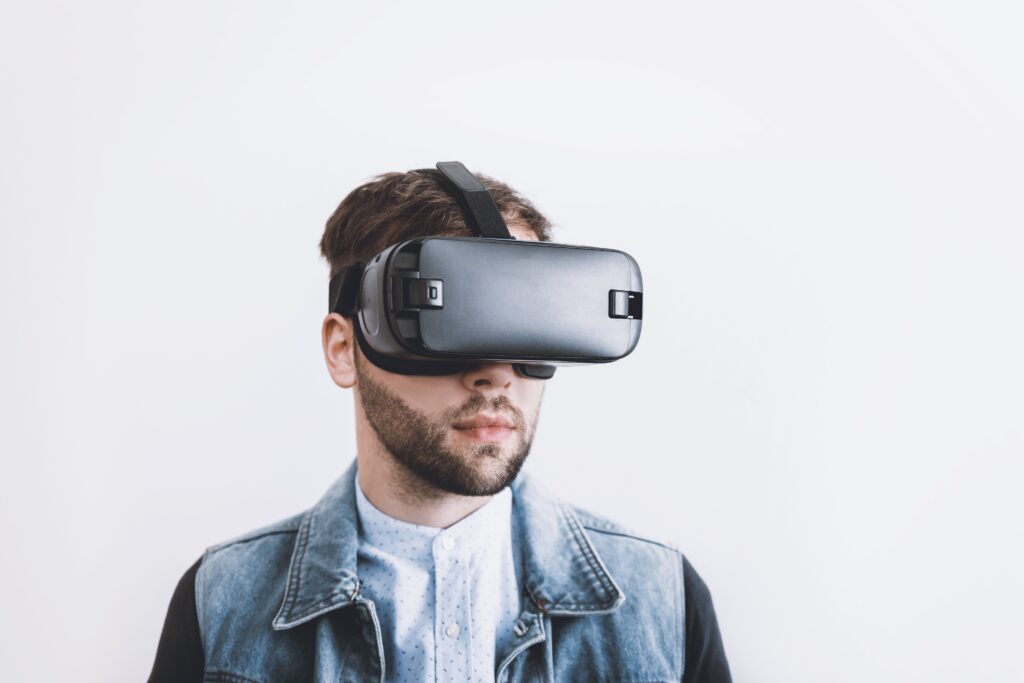Two promising sister technologies: Virtual Reality (VR) and Augmented Reality (AR), represent one of the pillars of future computing.
Overview:
Virtual reality (VR) and augmented reality (AR), two innovative technologies that provide a window into a completely new realm of human interaction with digital settings, serve as cornerstones in the ever-changing world of modern technology. This blog takes a close look at the complex worlds of virtual reality (VR) and augmented reality (AR), exploring their history, technological nuances, industrial applications, and moral dilemmas that come with their explosive growth.
Both represent our endeavor to replace the traditional interface. Although there are some fundamental differences between VR and AR, they have the same inherent idea behind their propagation, that is, ‘immersion.’ While the former immerses you in a virtually created environment, the latter creates and adds virtual elements in a real environment.
Both technologies store massive potential for various sectors like gaming, marketing, e-commerce, medicine, education, etc. Both technologies enhance the visual experience by integrating virtual elements and creating the virtual 3D world.
Virtual Reality & Augmented Reality: What’s the Difference?
Virtual Reality and Augmented Reality – sometimes, the line between these two technologies is blurred. While they share common traits, they convey two entirely different visions and specific uses. Both are two different technologies used for two very different purposes. Virtual Reality allows us to isolate ourselves from the world around us and immerse ourselves in a digitally created virtual environment. In contrast, Augmented Reality brings new virtual elements to the world around us. Let’s understand both technologies in more detail;
Virtual Reality And Its Applications
Virtual Reality allows the user to immerse in an artificial environment through the use of VR headsets. With the aid of a VR headset, users can enter a virtual environment and move in a universe created through digital technology and software. The video game industry was an early adopter of VR technology; however, it’s now finding applications across multiple sectors. The real estate industry is employing VR technology for virtual tours. Similarly, in the defense sector, VR is extensively used for training purposes. Likewise, the medical industry is also adopting VR for various applications like easing out patient’s stress levels, etc.
Virtual reality (VR) represents a significant shift in the way that tales are conveyed and experienced, not just a technical breakthrough. Virtual reality (VR) offers viewers a never-before-seen chance to actively engage with stories as well as observe them. This transcends the boundaries of traditional storytelling formats.
With the advent of virtual reality, storytelling has expanded beyond the limitations of conventional media to provide an engaging and interactive experience. With the further development of VR technology, the distinction between telling a tale and really experiencing it will become increasingly hazy, leading to a day when viewers actively participate in the stories that take place in the immersive virtual reality environments rather than only being spectators. The ingenuity of storytellers and the openness of listeners to exploring new narrative horizons are the only constraints on the interactive, immersive storytelling of the future.
Augmented Reality and Its Applications
Augmented Reality introduces virtual elements in real-world situations and environments. It’s like the superposition of virtual components in the real world. So, unlike Virtual Reality, Augmented Reality does not introduce users to a totally virtual environment. Instead, it enriches the real world with virtual elements. One great example of augmented Reality is the Pokemon Go game. Same as VR, Augmented Reality also finds exciting applications across various sectors. From military to sports and aviation to the medical sector, AR is creating new ways to achieve efficiency and enhance productivity.
Augmented reality, or AR, has become a game-changer in the ever-changing retail industry, changing the way buyer behavior and product engagement are shaped. AR is smoothly fusing the digital and physical worlds, providing a plethora of advantages for both customers and retailers. Examples of these benefits include virtual try-ons and interactive shopping experiences.
Retail is undergoing a radical transition toward more personalized, interactive, and engaging shopping experiences as augmented reality (AR) permeates more and more aspects of the sector. In a world where the lines between the digital and physical worlds are blurring and consumers are empowered to make more informed and fulfilling purchases, virtual try-ons and interactive features are more than just novelty items. They are the retail of the future. AR is at the vanguard of this growing retail scene, reshaping how we engage with products and shop in the twenty-first century.
Future of VR and AR Industry
The fields of virtual reality (VR) and augmented reality (AR), which have already seen quick developments, are set for an exciting future that might completely alter how humans view and engage with the digital and real worlds.Going by the speed of digital transformation and rapid growth of digital avenues, the future of the VR and AR industry seems bright. Also, these growing technologies present numerous applications, therefore, possess the potential to create numerous opportunities for businesses and individuals alike. Furthermore, the numbers suggest that the AR and VR market will reach 200 billion dollars by 2022. All in all, a bright future for both technologies!
The boundaries between the physical world and the digital one are constantly becoming more hazy as the VR and AR industries grow. The industry’s progress offers not only improvements in hardware and apps but also a significant shift in how we experience, learn, and interact, as technological innovation drives us forward. It’s an exciting trip into a world when VR and AR becomes the norm and the extraordinary becomes the new normal, with the only thing limiting our reality’s possibilities being the infinite imagination of individuals who are pushing the envelope of immersive technologies.
Conclusion
We are at the forefront of a technological revolution as we delve into the immersive realms of virtual reality and augmented reality. These technologies are crucial in our modern era and could open the door to an extraordinary future that was once only a part of science fiction. Join us on an immersive journey through the past, present, and future of virtual reality and augmented reality, where the lines between reality and fantasy are beautifully blurred and the possibilities are limited only by our collective imagination.



